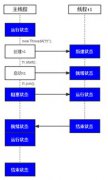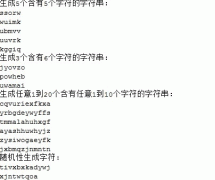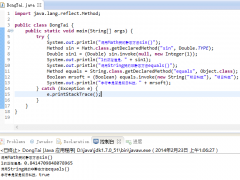14.7.4 Addition operator
For an operation of the form x + y, binary operator overload resolution (?4. 2.4) is applied to select a specific operator implementation. The operands are converted to the parameter types of the selected operator, and the type of the resul
For an operation of the form x + y, binary operator overload resolution (?4.
2.4) is applied to select a
specific operator implementation. The operands are converted to the
parameter types of the selected
operator, and the type of the result is the return type of the operator.
The predefined addition operators are listed below. For numeric and
enumeration types, the predefined
addition operators compute the sum of the two operands. When one or both
operands are of type string,
the predefined addition operators concatenate the string representation of
the operands.
?Integer addition:
int operator +(int x, int y);
uint operator +(uint x, uint y);
long operator +(long x, long y);
ulong operator +(ulong x, ulong y);
In a checked context, if the sum is outside the range of the result type, a
System.OverflowException is thrown. In an unchecked context, overflows are
not reported and
any significant high-order bits outside the range of the result type are
discarded.
?Floating-point addition:
float operator +(float x, float y);
double operator +(double x, double y);
The sum is computed according to the rules of IEC 60559 arithmetic. The
following table lists the
results of all possible combinations of nonzero finite values, zeros,
infinities, and NaN?s. In the table, x
and y are nonzero finite values, and z is the result of x + y. If x and y
have the same magnitude but
opposite signs, z is positive zero. If x + y is too large to represent in
the destination type, z is an
infinity with the same sign as x + y. If x + y is too small to represent in
the destination type, z is a
zero with the same sign as x + y.
y +0 -0 +8 -8 NaN
x z x x +8 -8 NaN
+0 y +0 +0 +8 -8 NaN
-0 y +0 -0 +8 -8 NaN
+8 +8 +8 +8 +8 NaN NaN
-8 -8 -8 -8 NaN -8 NaN
NaN NaN NaN NaN NaN NaN NaN
?Decimal addition:
decimal operator +(decimal x, decimal y);
If the resulting value is too large to represent in the decimal format, a
System.OverflowException
is thrown. The scale of the result, before any rounding, is the larger of
the scales of the two operands.
Decimal addition is equivalent to using the addition operator of type
System.Decimal.
?Enumeration addition. Every enumeration type implicitly provides the
following predefined operators,
where E is the enum type, and U is the underlying type of E:
E operator +(E x, U y);
E operator +(U x, E y);
The operators are evaluated exactly as (E)((U)x + (U)y).
?String concatenation:
string operator +(string x, string y);
string operator +(string x, object y);
string operator +(object x, string y);
The binary + operator performs string concatenation when one or both
operands are of type string. If
an operand of string concatenation is null, an empty string is substituted.
Otherwise, any non-string
argument is converted to its string representation by invoking the virtual
ToString method inherited
from type object. If ToString returns null, an empty string is substituted.
[Example:
using System;
class Test
{
static void Main() {
string s = null;
Console.WriteLine("s = >" + s + "<"); // displays s = ><
int i = 1;
Console.WriteLine("i = " + i); // displays i = 1
float f = 1.2300E+15F;
Console.WriteLine("f = " + f); // displays f = 1.23E+15
decimal d = 2.900m;
Console.WriteLine("d = " + d); // displays d = 2.900
}
}
end example]
The result of the string concatenation operator is a string that consists
of the characters of the left
operand followed by the characters of the right operand. The string
concatenation operator never returns
a null value. A System.OutOfMemoryException may be thrown if there is not
enough memory
available to allocate the resulting string.
?Delegate combination. Every delegate type implicitly provides the
following predefined operator, where
D is the delegate type:
D operator +(D x, D y);
The binary + operator performs delegate combination when both operands are
of some delegate type D.
(If the operands have different delegate types, a compile-time error
occurs.) If the first operand is null,
Chapter 14 EXPressions
161
the result of the operation is the value of the second operand (even if
that is also null). Otherwise, if the
second operand is null, then the result of the operation is the value of
the first operand. Otherwise, the
result of the operation is a new delegate instance that, when invoked,
invokes the first operand and then
invokes the second operand. [Note: For examples of delegate combination,
see ?4.7.5 and ?2.3. Since
System.Delegate is not a delegate type, operator + is not defined for it.
end note]
- 上一篇:我的Java,现在和未来
- 下一篇:ITS-CMS 2.0 URL设计构想
精彩图集
精彩文章





